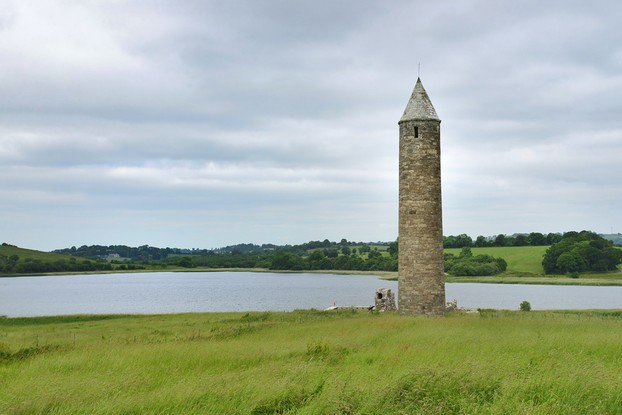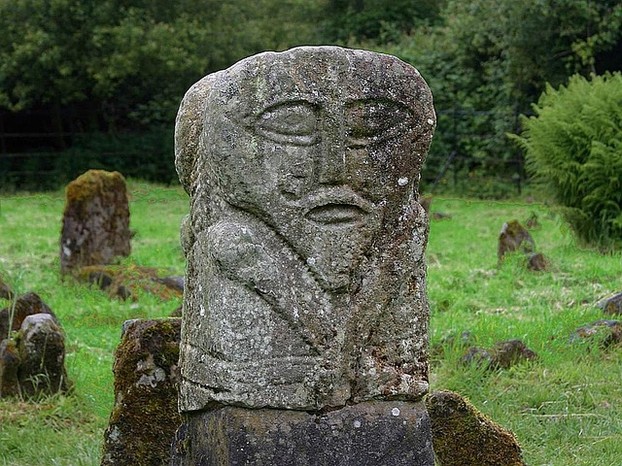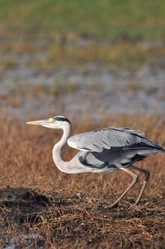It was once said that for half of the year Lough Erne is in Fermanagh and the other half of the year Fermanagh is in Lough Erne, and this saying derives from a time before flood controls were put in place,and these necessary institutions lowered the level of Lough Erne by about ten feet. The lower lough is the heart of the Fermanagh Lakeland and drains several smaller loughs into Lower Lough Erne on the Erne's journey to the sea. Upper Lough Macnean, half in Eire and half in the North, the lough on whose lovely shores I dwelt for a year in 1969-1970, is part of the Erne catchment area, draining ultimately into the Upper Lough. If you look at the map you will see where I dwelt, which is to the west of Belcoo, just before where the border turns northwards.
It is said that there are as many islands in Lough Erne as there are days in the year, but this is an exaggeration, there being about 97 in the Lower Lough and 57 in the narrower Upper Lough. The reason for there being so many islands is that the area is drumlin country, a terrain well-endowed with small mounds of glacial deposits pushed ahead of advancing glaciers, and when the land flooded after the Ice Age the drumlins stood out as islands
Between the two loughs is Enniskillen Island, on which is the historic centre of the town of Enniskillen. It is a pleasant market town, and when I lived in the region I often did my shopping there,hitching in th fourteen miles with a shopping list, passing the mediaeval castle of the Maguires on the way in. I have pleasant memories of the town.
In the distant past many of the islands were the sites of cranneogs, dwellings erected on wooden piles to raise them above the flood. Sometimes at the drier centre there was a rath, a small stone fortification, and several of these raths have survived as archaeological sites. As the lough was liable to swell in wet weather the shoreline was quite boggy, so it is likely that there were cranneogs inland from the modern shore. The cranneog dwellers must have been well fed, for the lough is rich in fish and wild fowl. Pollan, a freshwater type of herring is still found in the lough and there used to be a fishery that harvested it, and there were eels a-plenty, along with roach, trout and salmon.
A few of the islands are now inhabited.Some others are archaeological sites, but some have reverted to smal patches of semi-natural woodland, with trees such as alder and willow along with other small trees.








 Pilgrimage. A review26 days ago
Pilgrimage. A review26 days ago
 Leo the Fourteenthon 05/09/2025
Leo the Fourteenthon 05/09/2025
 The Melsonby Hoardon 03/25/2025
The Melsonby Hoardon 03/25/2025



Comments
The Sidhe were thought to be irritable and prone to take revenge
The Sidhe were thought to be irritable and prone to take revenge
The Sidhe were a fascinating mythological tradition
Irish folk creatures are usually portrayed as unfriendly ... but then, it makes for a better narrative in Ireland.
My son has bought me an Anthology of Irish Folk Lore for my birthday . Love it.
The computer crashed before I commenced another component to my question below.
Does Irish mythology describe its Sidhe matter-of-factly as irritable or is there an emotion or a judgment about such impartial, unmannerly attitudes?
Thank you for your comment below in answer to your previous comment and observation.
So the Scottish Sidhe must be non-irritable even as the Irish Sidhe remain irritable no matter what!
Why would there be such a difference between the two supernatural populations? Would Irish and Scottish mythologies have any reasons given?
The Irish Sidhe are said to be irritable, unlike the Scottish Sidhe
Thank you for your comment below in answer to my previous observation and question.
It intrigues me that Irish mythology introduces its supernaturals as irritable. Is it that the Sidhe seem hugely or mildly irritable, offense-taking and unfriendly?
Land in the north is held in the same way as land in Britain is, from the crown, but I do not know the rules for land in the south.
Is seeing leprechauns creepy or reassuring? I do not know, but we must realize that in Irish myth the Sidhe, the supernatural folk, are not regarded as friendly beings. They are considered irritable and therefore prone to take offence.
frankbeswick, Thank you for the photos, practicalities and products.
In another, more recent wizzley, you described the land in the United Kingdom as regarded as that of the monarchy at least since 1066. How did that affect the status of land with the creation of the Republic of Ireland and with its separation from the north? You mention above that some of the islands in the Lough Erne now are inhabited, and that made me start wondering about monarchical, private and public ownership in the two Irelands.
Is it supposed to be creepy or reassuring for Castle Crom's children to awaken to leprechauns smiling (enigmatically, fiendishly or nicely) and then vanishing through walls?